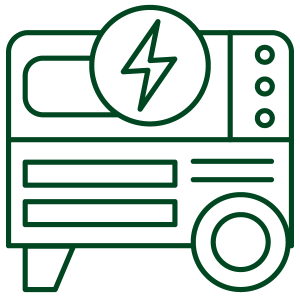Generator Safety
During power outages, many use backup electric generators for emergency electrical needs. If installed properly, use of generators to power your home, farm or business poses little danger. But, if installed incorrectly, your generator system could threaten the lives of family, friends, neighbors, and electric utility crews trying to restore service.
 There are specific ways to properly install generators in your business or home. Safe Electricity strongly suggests you have a qualified electrician assist you.
There are specific ways to properly install generators in your business or home. Safe Electricity strongly suggests you have a qualified electrician assist you.
To safely operate a standby generator, make sure it has a transfer safety switch to isolate the load from the normal utility source. Without this safety switch, there is a chance electricity can travel back through the lines, causing “back feed.” Back feed creates a dangerous hazard for anyone near lines, particularly utility crews working to restore power.
The transfer safety switch should be installed near the service entrance panel, or fuse box, in your home or business by a qualified electrician.
Some homeowners choose smaller, portable generators to power essential electrical equipment during outages. Dubois REC offers these tips for the safe operation and use of portable generators:
- Read and follow all manufacturer operating instructions
- Make sure the generator is properly grounded
- Never plug a portable electric generator into a wall outlet or connect directly to a home’s wiring. This can energize utility power lines and injure you or others working nearby. Electrical back feed also can damage the generator and home electrical equipment.
- Don’t overload the generator and plug in more appliances than the generator is rated to handle.
- Use only safety-tested, shop-type electrical cords designed and rated for heavier, outdoor use to connect appliances. Many generators are equipped with twist-lock connects to reduce the chance of accidental disconnection due to vibration.
- Always keep the generator outside in a dry, protected area, away from windows or air intakes where deadly exhaust fumes can enter living spaces. Equip homes with Carbon Monoxide (CO) alarms with battery backup.
- Turn off generator and allow to cool before refueling.
- Before shutting down a generator, turn off and unplug all appliances and equipment being powered by the generator.
Generator Dos and Don’ts
DO operate a generator outdoors in an area with plenty of ventilation.
DO install CO alarms inside the home to provide an early warning of carbon monoxide.
DO NOT plug a generator into the wall without installing a transfer switch to prevent backfeed.
DO turn the generator on before plugging in appliances.
DO NOT touch the generator with wet hands to avoid electrocution.
DO turn off the generator before refueling with gasoline to allow it to cool down.
DO NOT overload the generator.
DO use a heavy-duty, outdoor-rated extension cord rated at least equal to the sum of the connected appliances.
DO NOT use a generator as a permanent solution.
DO consult the owner’s manual for your generator for specific safety instructions.
